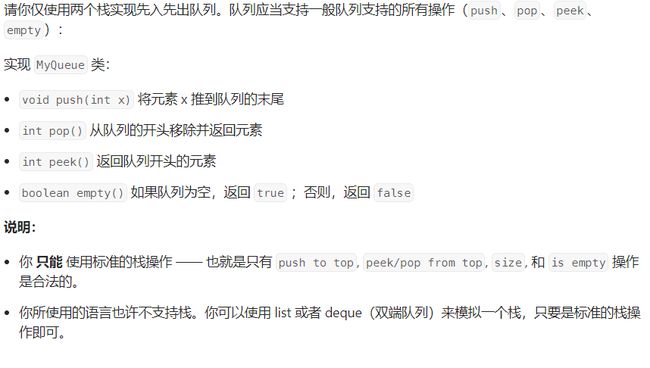数据结构——栈和队列OJ题
栈和队列小提升!
- 前言
- 一、用队列实现栈
-
- 队列接口实现
- (1)栈的接口定义
- (2)栈的初始化
- (3)入栈函数的定义
- (4)出栈函数的定义
- (5)查找栈顶元素
- (6)判空函数的定义
- (7)销毁函数的定义
- 二、用栈实现队列
-
- 栈的接口实现
- (1)队列的接口定义
- (2)队列的初始化
- (3)入队函数的定义
- (4)出队函数的定义
- (5)查找队头函数的定义
- (6)判空函数的定义
- (7)销毁函数的定义
- 三、设计循环队列
-
- (1)循环队列的接口定义
- (2)循环队列的初始化
- (3)判空函数的定义
- (4)判满函数的定义
- (5)循环队列插入函数的定义
- (6)循环队列删除函数的定义
- (7)查找队头函数的定义
- (8)查找队尾函数的定义
- (9)销毁函数的定义
- 总结
前言
欢迎来到专项提升小课堂!
今天的题目稍稍有难度哦!
但是只要用心,是难不倒同学们的!
一、用队列实现栈
提示:
1 <= x <= 9;
最多调用100 次 push、pop、top 和 empty ;
每次调用 pop 和 top 都保证栈不为空;
核心思想:
用队列模拟出栈的先入后出这一特性!
解题思路:
此题可以用两个队列去实现一个栈,每次始终保持一个队列为空,
入栈操作相当于给非空队列进行入队操作
出栈操作相当于非空队列的队尾元素出队,此时需要把非空队列除最后一个元素之外的其余元素入队到空队列,然后出队最后一个队尾元素
队列接口实现
先将队列的实现接口导入
这里涉及到之前队列建立的内容啦!
如果不了解的可以去看看:栈和队列
//头文件的声明
#include队列实现栈的功能函数的定义
(1)栈的接口定义
typedef struct {
Que q1;
Que q2;
} MyStack;
(2)栈的初始化
MyStack* myStackCreate() {
MyStack*pst = (MyStack*)malloc(sizeof(MyStack));
QueueInit(&pst->q1);
QueueInit(&pst->q2);
return pst;
}
(3)入栈函数的定义
void myStackPush(MyStack* obj, int x) {
if(!QueueEmpty(&obj->q1)){
QueuePush(&obj->q1,x);
}
else{
QueuePush(&obj->q2,x);
}
}
(4)出栈函数的定义
int myStackPop(MyStack* obj) {
Que*Empty=&obj->q1;
Que*nonEmpty=&obj->q2;
if(!QueueEmpty(&obj->q1)){
Empty=&obj->q2;
nonEmpty=&obj->q1;
}
while(QueueSize(nonEmpty)>1){
QueuePush(Empty,QueueFront(nonEmpty));
QueuePop(nonEmpty);
}
int top = QueueFront(nonEmpty);
QueuePop(nonEmpty);
return top;
}
(5)查找栈顶元素
int myStackTop(MyStack* obj) {
if(!QueueEmpty(&obj->q1)){
return QueueBack(&obj->q1);
}
else{
return QueueBack(&obj->q2);
}
}
(6)判空函数的定义
bool myStackEmpty(MyStack* obj) {
return QueueEmpty(&obj->q1)&&QueueEmpty(&obj->q2);
}
(7)销毁函数的定义
void myStackFree(MyStack* obj) {
QueueDestroy(&obj->q1);
QueueDestroy(&obj->q2);
free(obj);
}
二、用栈实现队列
提示:
1 <= x <= 9
最多调用 100 次 push、pop、peek 和 empty
假设所有操作都是有效的(例如,一个空的队列不会调用 pop 或者 peek 操作)
核心思想:
用栈模拟出队列的先入先出这一特性!
解题思路:
此题可以用两个栈实现,一个栈进行入队操作,另一个栈进行出队操作
出队操作: 当出队的栈不为空是,直接进行出栈操作,如果为空,需要把入队的栈元素全部导入到出队的栈,然后再进行出栈操作
栈的接口实现
先将栈的实现接口导入
这里涉及到之前栈的建立的内容啦!
如果不了解的可以去看看:栈和队列
//栈的接口定义
typedef int STDataType;
typedef struct Stack
{
STDataType* a;
int top;
int capacity;
}ST;
//初始化
void STInit(ST* ps);
//销毁
void STDestroy(ST* ps);
//插入
void STPush(ST* ps, STDataType x);
//删除
void STPop(ST* ps);
//查找栈顶元素
STDataType STTop(ST* ps);
//长度计算
int STSize(ST* ps);
//判断是否为空
bool STEmpty(ST* ps);
//初始化
void STInit(ST* ps)
{
assert(ps);
ps->a = NULL;
ps->capacity = 0;
ps->top = 0;
}
//销毁
void STDestroy(ST* ps)
{
assert(ps);
free(ps->a);
ps->a = NULL;
ps->top = ps->capacity = 0;
}
//插入
void STPush(ST* ps, STDataType x)
{
assert(ps);
if (ps->top == ps->capacity)
{
int newCapacity = ps->capacity == 0 ? 4 : ps->capacity * 2;
STDataType* tmp = (STDataType*)realloc(ps->a, sizeof(STDataType) * newCapacity);
if (tmp == NULL)
{
perror("realloc fail");
exit(-1);
}
ps->a = tmp;
ps->capacity = newCapacity;
}
ps->a[ps->top] = x;
ps->top++;
}
//删除栈顶元素
void STPop(ST* ps)
{
assert(ps);
assert(ps->top > 0);
--ps->top;
}
//查找栈顶元素
STDataType STTop(ST* ps)
{
assert(ps);
assert(ps->top > 0);
return ps->a[ps->top - 1];
}
//长度计算
int STSize(ST* ps)
{
assert(ps);
return ps->top;
}
//判断是否为空
bool STEmpty(ST* ps)
{
assert(ps);
return ps->top == 0;
}
栈实现队列的功能函数的定义
(1)队列的接口定义
typedef struct {
ST pushst;
ST popst;
} MyQueue;
(2)队列的初始化
MyQueue* myQueueCreate() {
MyQueue*obj = (MyQueue*)malloc(sizeof(MyQueue));
STInit(&obj->pushst);
STInit(&obj->popst);
return obj;
}
(3)入队函数的定义
void myQueuePush(MyQueue* obj, int x) {
STPush(&obj->pushst,x);
}
(4)出队函数的定义
int myQueuePop(MyQueue* obj) {
int front = myQueuePeek(obj);
STPop(&obj->popst);
return front;
}
(5)查找队头函数的定义
int myQueuePeek(MyQueue* obj) {
if(STEmpty(&obj->popst))
{
while(!STEmpty(&obj->pushst)){
STPush(&obj->popst,STTop(&obj->pushst));
STPop(&obj->pushst);
}
}
return STTop(&obj->popst);
}
(6)判空函数的定义
bool myQueueEmpty(MyQueue* obj) {
return STEmpty(&obj->popst)&&STEmpty(&obj->pushst);
}
(7)销毁函数的定义
void myQueueFree(MyQueue* obj) {
STDestroy(&obj->popst);
STDestroy(&obj->pushst);
free(obj);
}
三、设计循环队列
提示:
所有的值都在 0 至 1000 的范围内;
操作数将在 1 至 1000 的范围内;
请不要使用内置的队列库。
核心思想:
首尾相连循环即为环形!
解题思路:
通过一个定长数组实现循环队列
入队:首先要判断队列是否已满,再进行入队的操作,入队操作需要考虑索引循环的问题,当索引越界,需要让它变成最小值
出队:首先要判断队列是否为空,再进行出队操作,出队也需要考虑索引循环的问题
判空: 队头 == 队尾
判满: 队尾 + 1 == 队头
(1)循环队列的接口定义
typedef struct {
int *a;
int front;
int rear;
int k;
} MyCircularQueue;
(2)循环队列的初始化
MyCircularQueue* myCircularQueueCreate(int k) {
MyCircularQueue*obj=(MyCircularQueue*)malloc(sizeof(MyCircularQueue));
obj->a=(int*)malloc(sizeof(int)*(k+1));
obj->front=obj->rear=0;
obj->k=k;
return obj;
}
(3)判空函数的定义
bool myCircularQueueIsEmpty(MyCircularQueue* obj) {
return obj->front==obj->rear;
}
(4)判满函数的定义
bool myCircularQueueIsFull(MyCircularQueue* obj) {
return (obj->rear+1)%(obj->k+1)==obj->front;
}
(5)循环队列插入函数的定义
bool myCircularQueueEnQueue(MyCircularQueue* obj, int value) {
if(myCircularQueueIsFull(obj))
return false;
obj->a[obj->rear]=value;
obj->rear++;
obj->rear%=(obj->k+1);
return true;
}
(6)循环队列删除函数的定义
bool myCircularQueueDeQueue(MyCircularQueue* obj) {
if(myCircularQueueIsEmpty(obj))
return false;
++obj->front;
obj->front%=(obj->k+1);
return true;
}
(7)查找队头函数的定义
int myCircularQueueFront(MyCircularQueue* obj) {
if(myCircularQueueIsEmpty(obj))
return -1;
else
return obj->a[obj->front];
}
(8)查找队尾函数的定义
int myCircularQueueRear(MyCircularQueue* obj) {
if(myCircularQueueIsEmpty(obj))
return -1;
else
return obj->a[(obj->rear+obj->k)%(obj->k+1)];
}
(9)销毁函数的定义
void myCircularQueueFree(MyCircularQueue* obj) {
free(obj->a);
free(obj);
}
总结
今天的题目难度真的不小哦!
但也要相信自己!
自信就是最好解决问题的方法!











